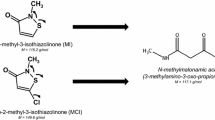Summary
The metabolites of tritiated 4‴-methyldigoxin (MD) has been studied in bile, urine and faeces from 3 patients 24 h after cholecystectomy and T-tube drainage. 5.6–15.6% of the doses were eliminated in bile and 28.5–57.8% in urine within 48 h. In bile after 6 h, approximately 5% of the excreted products were bisglycosides (B) and only traces were monoglycosides (M), whereas 55.3±4.5% were CHCl3-insoluble metabolites. At the same time urine contained 15.5±1.3% CHCl3-insoluble compounds. Anaerobic incubation of bile with a stool suspension (SS) decreased the polar fraction by 64.8±4.5% (n=6); incubation with a previously autoclaved SS decreased it only by 12.7±2.7%. Preincubation of SS with carbenicillin, cephalotin and ampicillin to depress bacterial growth largely suppressed the metabolic activity. TLC-analysis revealed that the decrease in the polar fraction corresponded to an increase of M, whilst MD, digoxin and B were almost unaltered. The results imply that B and M were formed in the liver, B was preferentially eliminated unchanged in bile and M was conjugated to CHCl3-insoluble compounds prior to excretion. The polar conjugates were split by bacterial enzymes in the colon to yield M, which could be detected in faeces.
Similar content being viewed by others
References
Abshagen, U., Bergmann, K. v., Rietbrock, N.: Evaluation of the enterohepatic circulation after3H-digoxin administration in the rat. Naunyn-Schmiedeberg's Arch. Pharmacol.275, 1–10 (1972)
Abshagen, U., Rietbrock, N.: Metabolism of digoxigenin, digoxigeninmonodigitoxoside and digoxigeninbisdigitoxoside in rats. Naunyn-Schmiedeberg's Arch. Pharmacol.276, 157–166 (1973)
Abshagen, U.: Stoffwechsel und Kinetik von Digoxin, α-Acetyldigoxin, β-Acetyldigoxin und β-Methyldigoxin beim Menschen. Habilitationsschrift Berlin 1973
Bergmann, K. v., Abshagen, U., Rictbrock, N.: Quantitative analysis of digoxin, 4‴-acetyldigoxin and 4‴-methyldigoxin and their metabolites in bile and urine of rats. Naunyn-Schmiedeberg's Arch. Pharmacol.273, 154–167 (1972)
Brown, B.T., Shepheard, E.E., Wright, S.E.: The distribution of digitalis glycosides and their metabolites within the body of the rat. J. Pharmacol. exp. Ther.118, 39–45 (1956)
Cox, E., Wright, S.E.: The hepatic excretion of digitalis glycosides and their genins in the rat. J. Pharmacol. exp. Ther.126, 117–122 (1959)
Dengler, H.J., Bodem, G., Wirth, K.: Pharmacokinetic and metabolic studies with lanatoside C, α- and β-acetyldigoxin and digoxin in man. In: Fifth Intern. Congress on Pharmacology, San Francisco 1972, p. 112. Basel: Karger 1973
Doherty, J.E.: Clinical pharmacology of digitalis glycosides. A review. J. med. Sci.255, 382–414 (1968)
Harrison, C.E., Brandenburg, R.O., Ongley, P.R., Orvis, A.L., Owen, C.A.: The distribution and excretion of tritiated substances in experimental animals following the administration of digoxin-3H. J. Lab. clin. Med.67, 764–777 (1966)
Hawksworth, G., Drasar, B.S., Hill, M.J.: Intestinal bacteria and the hydrolysis of glycosidic bonds. J. med. Microbiol.4, 451–453 (1971)
Herrmann, I., Repke, K.: Über eine neue Form der Konjugation von Geninen im tierischen Stoffwechsel. Naunyn-Schmiedebergs Arch. exp. Path. Pharmak.243, 333–334 (1962)
Herrmann, I., Repke, K.: Entgiftungsgeschwindigkeit und Kumulation von Digitoxin bei verschiedenen Species. Naunyn-Schmiedebergs Arch. exp. Path. Pharmak.247, 19–34 (1964)
Kaiser, F.: Die papierchromatographische Trennung von Herzgiftglykosiden. Chem. Ber.88, 556–563 (1955)
Kolenda, K.-D., Lüllmann, H., Peters, D.: Metabolism of cardiac glycosides studied in the isolated perfused guinea-pig liver. Brit. J. Pharmacol.41, 661–673 (1971)
Kuhlmann, J., Abshagen, U., Rietbrock, N.: Pharmacokinetics and metabolism of digoxigeninmonodigitoxiside in man. Europ. J. clin. Pharmacol. (in press)
Lage, G.L., Spratt, J.L.:3H-Digoxin metabolism by adult male rat tissues in vitro. J. Pharmacol. exp. Ther.149, 248–256 (1965)
Marcus, F.J., Burkhalter, L., Luccia, C., Pavlovich, J., Kapadia, G.J.: Administration of tritiated digoxin with and without a loading dose Circulation34 865–874 (1966)
Repke, K.: Die Bis- und Monodigitoxoside des Digitoxigenins und Digoxigenins: Metabolite des Digitoxins. Naunyn-Schmiedebergs Arch. exp. Path. Pharmak.237, 155–170 (1959)
Repke, K.: Stoffwechsel und Wirkung von Digitalisglykosiden. Öst. Apoth.-Ztg.24, 515–522 (1970)
Rietbrock, N., Rennekamp, Ch., Rennekamp, H., Bergmann, K. v., Abshagen, U.: Demethylation and cleavage of glycosidic bonds of 4‴-methyldigoxin in man. Naunyn-Schmiedeberg's Arch. Pharmacol.272, 450–453 (1972)
Rietbrock, N., Abshagen, U.: Stoffwechsel und Pharmakokinetik der Lanataglykoside beim Menschen. Dtsch. med. Wschr.98, 117–122 (1973)
Scheline, R.: Drug metabolism by intestinal microorganisms. J. pharm. Sci.57, 2021–2037 (1968)
Author information
Authors and Affiliations
Rights and permissions
About this article
Cite this article
Abshagen, U., Rennekamp, H., Küchler, R. et al. Formation and disposition of bis- and monoglycosides after administration of3H-4‴-methyldigoxin to man. Eur J Clin Pharmacol 7, 177–181 (1974). https://doi.org/10.1007/BF00560378
Received:
Accepted:
Issue Date:
DOI: https://doi.org/10.1007/BF00560378




